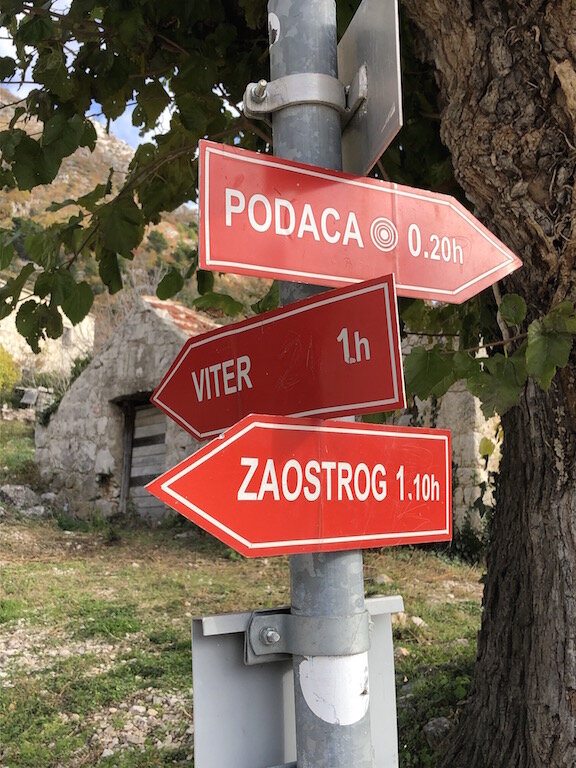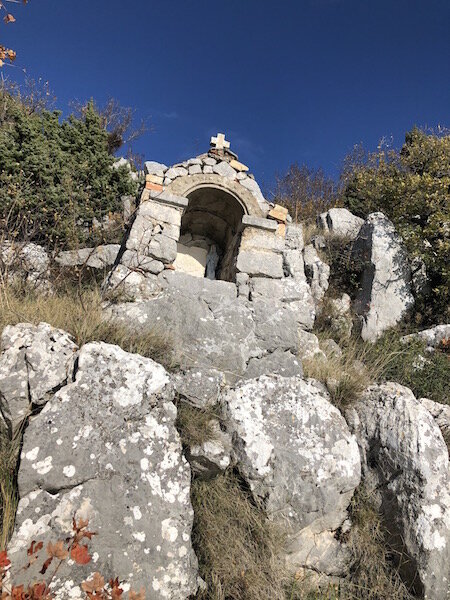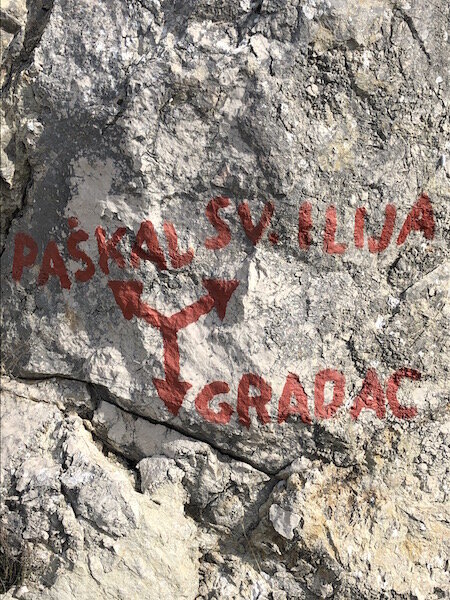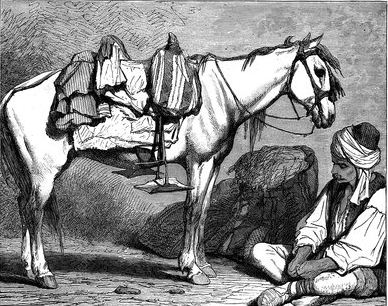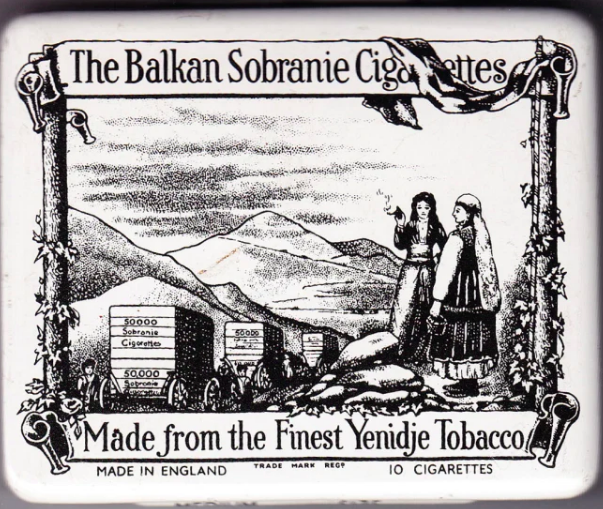“A beautiful view of the sea, promontories, and islands, perfectly enjoyed from the above, was almost the sole award for our efforts .””
During the two years I spent living on the strip of the Croatian coast known as the Makarska Riviera I covered a lot of ground on foot. Often I would just set out and let a road or trail lead me along, having learned to trust that the slopes and ridges of Biokovo would not fail to impress me with the secrets it held.
“You really like going upstairs,” one friend remarked to me.
“Yes, upstairs is where all the magic is…” was my reply.
It is that magic that keeps me returning to this corner of Croatia, year after year.
About 12 kilometres south from where I lived is the coastal village of Drvenik, which I ended up unintentionally walking to by following old trails that traversed the high ridges.
I was lured there when I stood gawking at the view of the sweeping valley below. Scanning the lay of the land, my eyes landed on a the pointy tipped cypress trees and stone ruins clustered on top of medieval looking hillock.
This is often how I travel through the landscape - spotting something in the far distance and aiming for it.
The D-8 highway clings to the Dalmatian coast, swinging by villages and sparkling bays that hog all the attention. Above every village along this coast sit layers of ancestral history left behind by those that once resided high above the seaside…Purposely choosing the safety of the mountains, they grew crops, raised livestock, and built villages in the safety of the hills rather than down on the coast that was vulnerable to a sea full of pirates.
The landscape in this southern part of the region is monumental and dramatic. Pristine bays lined with pine forests are abruptly met by the tail end of the Dinaric Alps - a bewitching backdrop of towering grey massifs. Drvenik, and the nearby villages of Zaostrog, Brist, Podaca, and Gradac sit at the bottom of a green bowl of a valley that stretches up from the sea to high ridges and pointed peaks.
View from Gradina fortress
Gradina fortress ruins
Packed into the hills above Drvenik, ruins of settlements, and relics from the past sit quietly amongst ancient olive groves where the history is far more ancient than the trees. A network of trails criss cross through the valley and up over the ridges to the hinterland. Trails that connect the centuries of civilizations are scratched into the hills here and throughout Dalmatia.
Thanks to a proactive tourist board not all has been forgotten or left to be swallowed up by nature. I do not know who to thank for the fact that I almost always have this corner of Dalmatia to myself!
It is places like Drvenik that are precisely why I am so hooked on exploring and hiking in Croatia.
FORTIS THE EXPLORER
““Oh, how many corrections in their systems the most famous writers would make, if only they travelled a little bit more!””
Alberto Fortis
Alberto Fortis, a 17th century Venetian scholar, was a jack of all trades - starting out, but booted out of theology, perhaps because of his unabashed wanderlust. His heart and mind heavily immersed in the natural sciences, he had his hands in everything in regards to how the earth was formed, and how the world worked. He also had the proper mindset for an intrepid traveller - perhaps slightly obsessed, driven by a curious and restless passion for exploring.
Illustration of the Morlach people
He definitely had Dalmatia on the brain, returning 11 times on various expeditions funded by Venice, and a handful of other dukes, lords and philanthropists. He conducted and collected specimens for his tireless research on everything from the karst stone and caves, fishing customs, flora and fauna, and the people that lived in Venetian ruled Dalmatia. Ultimately it was his personal accounts of his forays amongst the life, and customs of the hardy people living on the other side of these mountains, who he called the Morlachs, that put him in the limelight. His book, Viaggo in Dalmazia (Travels in Dalmatia), came out in, 1774 and suddenly he was the man of the moment, captivating the Enlightened imaginations of cultured Europe. Translated into many languages this book can be considered one of the early travelogues, and certainly one of the first in depth accounts of this region.
I started delving into where I had been exploring, and Fortis came up in almost any search about Drvenik, due to the trails that climb the rugged passes up from Drvenik, Gradac, and Zaostrog; connecting the coast to the inland. Fortis describes travelling over these ridges in the 17th century. and a pit stop in the hinterland village of Kokorici, where he was a special guest of the Duke of Pervan.
Serpentine tracks above Gradac
HIKING & WALKING THROUGH HISTORY
Modern day Drvenik, Gradac, Brist, Podaca and Zaostrog are pretty seaside villages thronging with tourists that flock to the Makaraska Riviera and its beaches. But sitting in the quiet hills above, there is plenty of history and natural beauty accessed via pretty walks along roads that tie the villages together like a string across the upper slopes. Veer upwards via hiking signposts along switchback trails to grand heights and panoramic views.
This southern corner of the Dalmatian coast does a great job of offering my favourite Croatia combination - hiking, history, atmospheric ruins, and a good dose of legends and stories imbedded into a setting so beautiful you are surprised there is not a soul to be seen.
DRVENIK HIKE - Drveničke stine
Interesting Facts: This route was not only used by shepherds who took their animals up to the fields in the highlands, but it was also a transport trade route that connected the coast to the hinterland. Read below about the Tobacco Roads!
Level: Difficult
Time to to Drveničke stine 2 - 3hr.
View from Top: Incredible
https://planinarenje.hr/staze/drvenik-sokolic?odrediste=drvenicke-stine-vrh-sokolic
Drvenik hike to Drveničke Stine (and Sokolic) begins in the village Staro Selo. There is a hiker’s sign though a bit lower, signposted at the parking lot for chapel of Sv. Jure. Head left for Drveničke stine. Look for the red and white circles, the universal hiking marking signs, on the stone walls, near an old house. The trail is clear, switchback route. One you reach Drvenicke Stine, you can continue to Sokolic but that part is quite treacherous, and not very relaxing as you must traverse very sharp rocks, on a narrow stretch flanked with steep cliffs. Unless you are experienced, and prepared it is recommended to enjoy in your triumph when you have reached Drveničke Stine.
GRADAC HIKE
Gradac to Sveti Ilija peak ( a nice alternative option is to turn off to Sveti Pascal chapel on another peak)
Interesting Facts: Sveti Pascal is a tiny stone chapel, the oldest structure known in the region sitting high on the ridge with breathtaking views. Great picnic spot!
Level: Medium
Time to top: 3 hours *Sveti Pascal 2.5 hr
View: astonishing - view of the ridges of Biokovo and coast, and in other direction BIH, Neretva Valley and Bacina lakes.
Sveti Paskal chapel ruins and the spine of Biokovo
RESPECT THE MOUNTAINS
Please note that in the summer, the heat is intense, and there is no water, and very little shade on these trails. I do not recommend hiking the higher routes on Biokovo from mid June, July and August. Respect the mountain! These routes were chosen by the smugglers for a reason!
Do not hike alone, and travel with more water than you expect you will need, wear proper footwear, carry a charged phone with a maps app like maps.me - always helpful!
Or even better support a small business and hire a guide!
https://www.lifeandventures.com
ZAOSTROG (or Podaca) HIKE - Zaostrog to Viter
Interesting facts: What was an old caravan route connecting the coast and the hinterland. Viter viewpoint was the site used as an observation point to keep a lookout for invading Turks.
A Prehistoric stone tool was also found on Viter!
Trail Level: Medium to Difficult
Time to Viter: 3 hrs. Marking is average but not new so keep your eyes out, especially where to turn left up to Viter after you reach the ridge.
View: Incredible
THE TOBACCO ROUTES
It was not only Fortis who tromped and picked his way along these routes examining rocks, dining with dukes, and translating folklore love ballads.
Others left their legacy throughout the centuries. The routes that are etched into the hills and ridges are still clear today, forged through the mountain passes long ago, under secrecy and often under the darkness of night.
Hercegovinian gold - Tobacco was one of the few crops that grew well in the stony ground of the hinterland and it was a product the hard scrabble peasants could trade on the Dalmatian coast - but much of this business was done illegally, transported to the coast out of sight of the ruling thumbs of various empires. The production and sale of tobacco was strictly controlled - thus transporting the tobacco secretly through the mountains was the only option for many.
““I set off from Drvenik to run over Biokovo on horseback, but it was not possible to continue the journey so comfortably. Trails at the highest part of the mountain often run between rocky boulders, and sometimes they are on the edge of an abyss. When I crossed the top of Biokovo, I passed partly on foot and partly in the saddle, led by the companions that the court duke PERVAN from Kokorić had sent me. The path.. to this village in the interior is less than five miles; but they (the locals) walk with miraculous skill, climbing the steepest cliffs and descending down the steepest cliffs where it would be said that only birds can pass. It took me six fat hours to cross the mountain by a four-legged road; and at last I reached the home of that good duke who received me with sincere cordiality. The houses of this virtuous man were built in the shape of a Turkish tower… The house girls stood behind the cracks in the door to look at me and my cartoonist as two strange animals, both in suit and demeanor.””
Historical records from the Dubrovnik Republic mention tobacco - and it being banned as a trade good. So, it is quite possible Fortis ran into some of these outlaw travellers along the way, or perhaps they were working as double agents as his porters…
I imagine a line of mules hauling loads of dried tobacco leaves, coming around a corner in the trail to find Fortis picking his way along with his cumbersome travelling laboratory - followed by his willing (or not willing) personal illustrator.
They cross paths up there in the middle of nowhere… just as I have come upon the occasional shepherd on a corner - both of us quite shocked to come across another human up there.
“‘...He always had a geological hammer, scalpel, bottles with acids, compass, barometer, thermometer, callipers for measuring layer thickness, simple microscope, telescope and metal points for testing hardness of the materials. He also used to carry arms, notebooks, drawing kit, topographic map, geographic books with detailed descriptions of the prospected area and sample containers for palaeontological, archaeological, and zoological samples, or mineral water and gas samples in volcanic areas.’”
Fortis for all his efforts, must have been captured by a certain obsession to take on the reconnaissance missions, again and again. Traipsing along the crossroads of the Ottoman, Austrian Empires and the Venetian Republic; he was certainly a pioneer of his time.
Fortis’ forays, and the ‘Tobacco roads’ tales are a good bit of ‘wild west’ Dalmatian history that I guarantee you will think about as you climb, arriving to a view of both the sea and the undulating grey peaks of the hinterland stretching out endlessly on the other side. Thanks to the shepherds and smugglers that trod out these trails, and the volunteers of the Croatian mountaineering association - they are now well marked as hiking routes to enjoy rewarding views from beginning to end. You will come across small shrines at turns in the trail, testaments to the dangers and challenges the travellers undertook long ago.
SITES AND SIGHTS IN THE HILLS
Gradina fortress ruins
GRADINA FORTRESS
Gradina fortress dates back to 1000 BC and was attacked and burnt to the ground by the Turks in a battle in 1687. The fortress had only the women of the village to defend it, and according to stories it was a mighty battle while all the men were away fighting off the Ottoman advances elsewhere.
Illyrian ruins, above Drvenik
THE ILLYRIANS WERE HERE TOO…
Just across the way, and a hike that cuts up the slope between stone walls leads to traces of a large Illyrian settlement. A bronze age civilization that ruled this region including the islands, and led by their queen Teuta. The legacy of the Illyrians can also be found in the stone burial mounds in this valley and throughout Dalmatia. It was from these people and their language, that this land earned the name, Dalmatae.
Kostanica Greb
MEDIEVAL TOMBSTONES
Stecci - monumental medieval tombstones are scattered throughout the region, often in clusters. But here up high, a singular and poignant 15thc stecak, the Kostanica Greb, sits alongside a road overlooking Gradina fortress and the valley. I try to imagine getting it there in the first place! Barely visible reliefs worn away by the centuries tell the folkloric tale of a girl in the middle of a love duel. Two men on horseback fight over her - a battle between a Turk and a local with the name Kostanic. This massive slab of stone marks the site, and is the tombstone for Kostanic who was killed in the fight.
Staro selo
STARO SELO
If that is not enough, the old village with the name that means exactly that - Staro selo, sits at the dramatic intersection where the slope meets the steep cliffs. People have resided since the 13th century until the earthquake in 1962 drove most inhabitants down to the coast. Rather intact, and very pretty - some people have been returning and restoring the buildings. It is also the access point for the Sokolic hike up and over the ridge.
Ruins of smaller hamlets sit quietly in the further outlying slopes - reached along red dirt roads passing through acres of olive groves.
Holding their own stories for the few that venture out that far.
INFO & TIPS
Drvenik & the Makarska Riviera region
Drvenik is also a small port where there is a car ferry accessing Hvar island, arriving on the eastern end to the pretty village of Sucaraj. It is a nice alternative route to reach or come to the mainland from the island (as opposed to the Split ferry port).
Ferry info: https://www.jadrolinija.hr/en/ferry-croatia
The nearest large town is Plcce to the south, for a larger supermarket, gas stations etc, and Makarska up the coast 42 km is the hub for the region. Drvenik and other villages all have small supermarkets, and apartments for rent.
Nearby sights - Biokovo Nature park, and the Skywalk - for a jawdropping drive and views, history, and hiking trails
https://pp-biokovo.hr/en/23/info-for-visitors
Budanko Travel. For Hiking, and other excursion tours on Biokovo and the region https://www.budankotravel.com/hr/
Explore the coast. There are many pretty villages and secluded bays for swimming and other hiking spots; all found along the 70 km stretch of the Makarska Riviera.
Reached by Split, Drvenik is just over 1 hours drive south. Buses run from Split, Makarska, Ploce, Dubrovnik. From Dubrovnik driving is 3.5 hours and you must pass through BIH border control, and out again.
Drvenik Tourist board https://www.drvenik.hr/
Adventure Excursions - Life and Ventures. Experts in the area, and worth checking out for guided tours https://www.lifeandventures.com/









